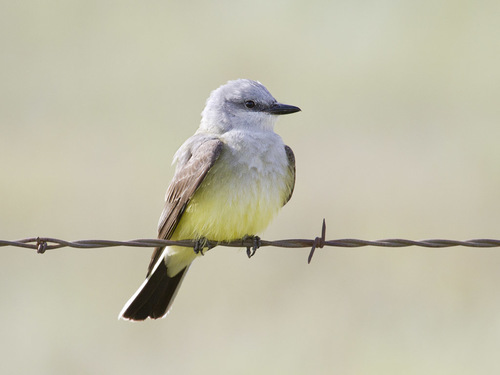
Western Kingbird
The Western Kingbird (*Tyrannus verticalis*) is a striking flycatcher known for its assertive behavior and distinctive appearance. Often found in open habitats across western North America, this bird plays a vital role in controlling insect populations. It is easily recognizable by its gray head, yellow belly, and white-edged black tail. While not globally threatened, the Western Kingbird faces regional challenges due to habitat loss and pesticide use. It holds no particular widespread cultural significance, but its bold nature and conspicuous perching habits make it a favorite among birdwatchers.
20-24 cm
Length
38-40 cm
Wingspan
Least Concern
Conservation Status
Distribution
The Western Kingbird breeds across western North America, from southern Canada down to northern Mexico. During the winter, it migrates to Central America and southern Mexico, with some individuals reaching as far south as Costa Rica. Its altitudinal range extends from sea level to about 2,500 meters.
Lifespan
Typical lifespan in the wild is 4-6 years, though some individuals may live longer.
Western Kingbird's Habitat
Habitat Types
Open grasslands, Savannas, Agricultural fields, Riparian woodlands, Urban parks
Climate Zones
Temperate, Arid, Semi-arid
Adaptations
Western Kingbirds prefer open habitats with scattered trees or perches, which provide excellent vantage points for spotting flying insects. They are well-adapted to human-modified landscapes, often nesting on utility poles and buildings.
Variations
No distinct subspecies are currently recognized, although minor variations in plumage and size may occur across its extensive range.
Appearance
Breeding Plumage
Plumage is generally similar year-round. The upperparts are grayish-olive, the head is gray, and the underparts are pale yellow. The tail is black with distinct white outer edges.
Seasonal Feather Changes
Minimal seasonal variation. Freshly molted birds may appear slightly brighter.
Sex Based Plumage Differences
Males and females have nearly identical plumage.
Notable Features
Bright yellow belly, Black tail with white outer edges, Gray head and back, Small, concealed red crown patch (rarely visible)
Diet and Feeding
Primary Foods
Flying insects, Beetles, Wasps, Flies, Grasshoppers, Moths
Foraging Behavior
Western Kingbirds are primarily 'sally' hunters. They perch on exposed locations and fly out to catch insects in mid-air. They may also glean insects from foliage or occasionally eat berries.
Specializations
Their wide gape and agile flight are adaptations for capturing flying insects.
Seasonal Diet Variations
Diet is primarily insects during the breeding season. In the non-breeding season, they may incorporate more fruits and berries, particularly in their wintering grounds.
Behavior
Social Structure
Generally territorial during the breeding season, defending nesting sites from other kingbirds and even larger birds. Outside of breeding, they may form small flocks, especially during migration.
Communication
Sharp, chattering calls ('kip' or 'kip-kip-kerrr'), Dawn song, a rapid series of calls, Wing fluttering during aggressive encounters
Migration
Western Kingbirds are long-distance migrants, traveling between their breeding grounds in North America and their wintering grounds in Central and South America. Migration is triggered by changes in day length and food availability.
Territorial or Group Behaviors
Highly territorial during breeding, aggressively defending their nesting territory against intruders, including larger birds like hawks and crows. They are known for their fearless attacks on perceived threats.
Conservation
Threats
Habitat loss (due to agriculture and urbanization), Pesticide use (reducing insect prey and causing direct poisoning), Collisions with vehicles and structures
Protection Programs
Migratory Bird Treaty Act (protection in the US), Conservation efforts focused on preserving open habitats
Local National Laws
Protected under the Migratory Bird Treaty Act in the United States, Canada, and Mexico.
Population Trend
Stable
Population Estimates
Global population estimated at 18 million.
Interesting Facts
Western Kingbirds are known for their aggressive defense of their nests.
They will fearlessly attack much larger birds, including hawks and crows, that venture too close.
They have a small, red crown patch.
This patch is usually concealed but can be displayed during courtship or aggressive encounters.
Western Kingbirds often reuse nest sites in subsequent years.
This behavior is more common in areas with limited suitable nesting locations.
Their scientific name, *Tyrannus*, reflects their bold personality.
The genus name *Tyrannus* means 'tyrant', 'despot', or 'king', referring to their aggressive behavior.
Faqs about Western Kingbird
What do Western Kingbirds eat?
They primarily eat flying insects, catching them in mid-air. They may also eat some berries, especially during migration and winter.
Where do Western Kingbirds migrate?
They migrate from their breeding grounds in western North America to wintering grounds in Central America and southern Mexico.
Are Western Kingbirds aggressive?
Yes, they are known for their aggressive defense of their nesting territories, often attacking much larger birds.
How can I attract Western Kingbirds to my yard?
Provide open areas with perches and avoid using pesticides. Planting native trees and shrubs can also help create suitable habitat.
Copyright @ Nature Style Limited. All Rights Reserved.
 English
English